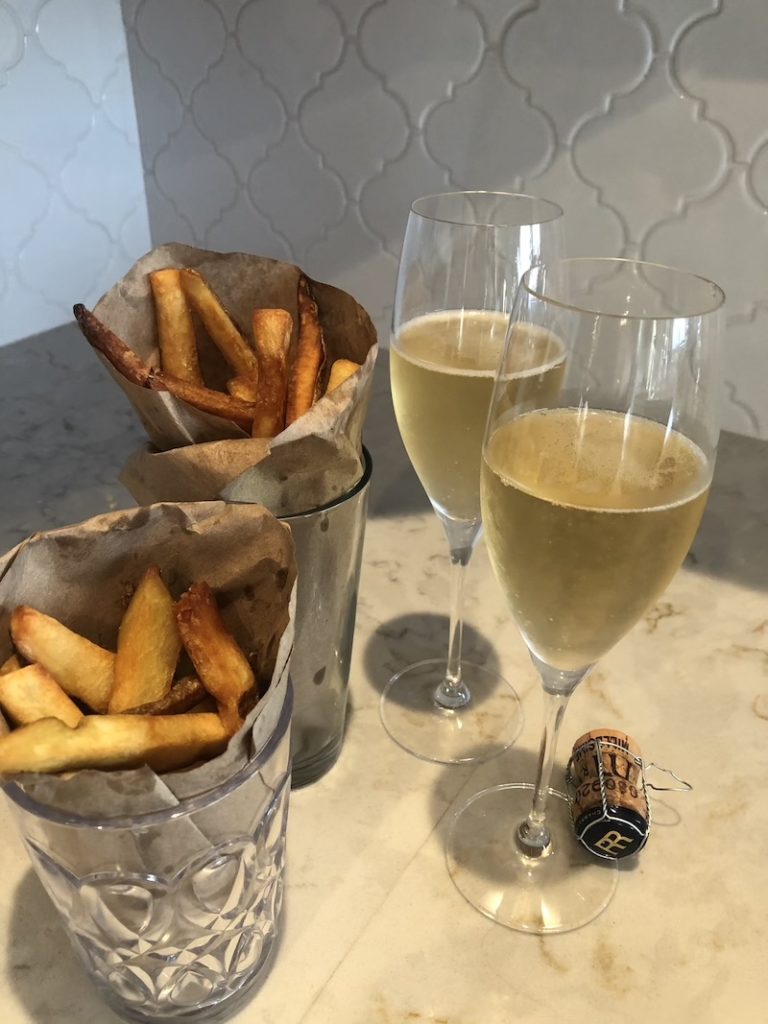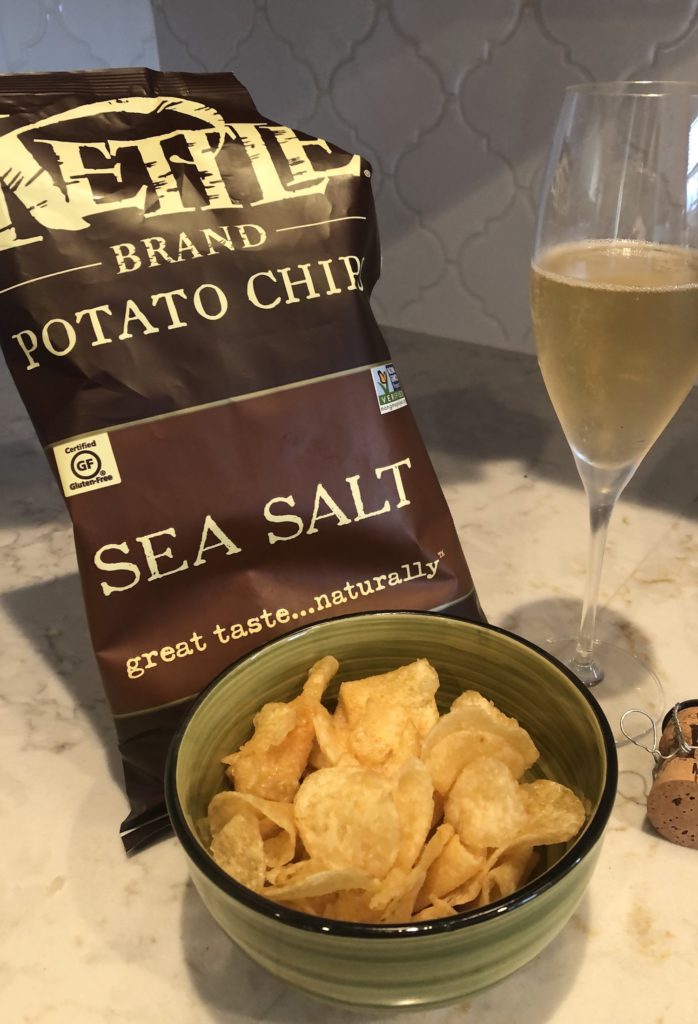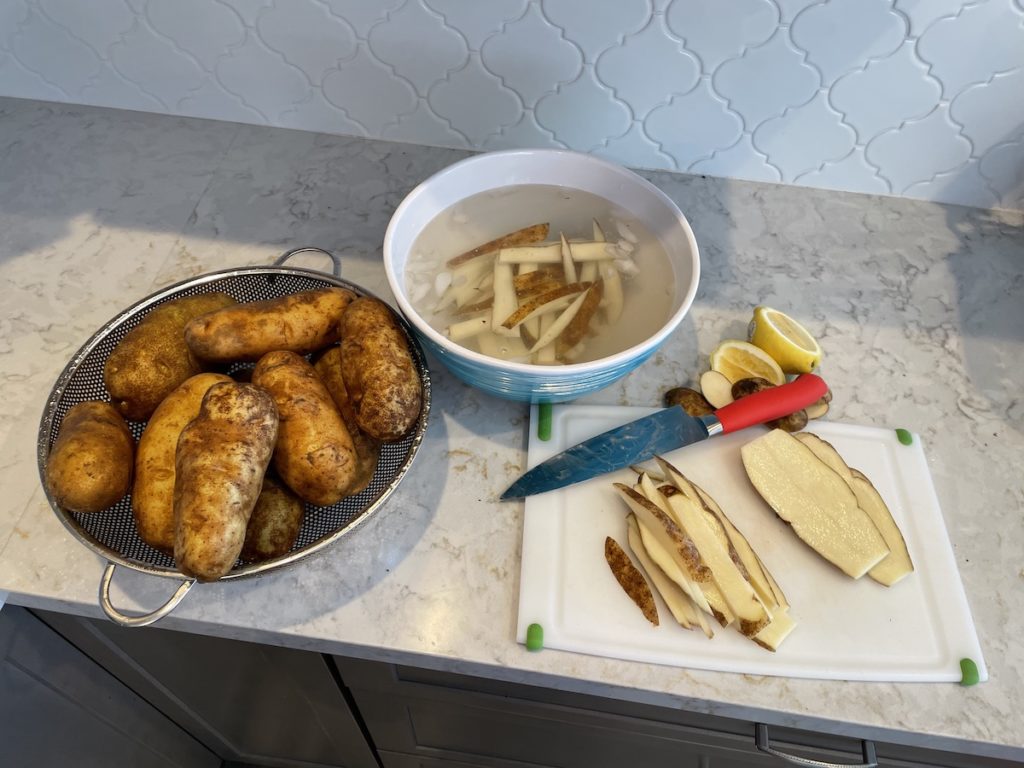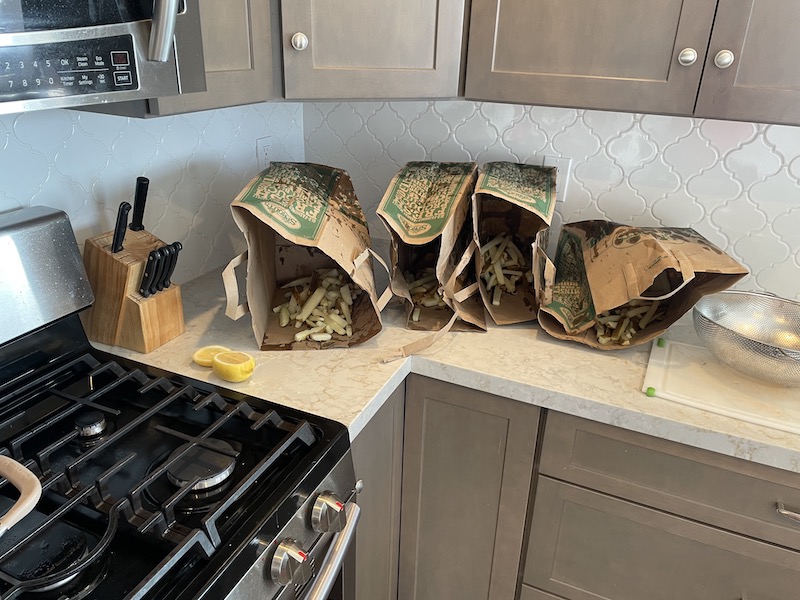That could easily be the tagline for my life, but it’s actually an idea for a cookbook I’m starting to write titled Better Next Time. The inspiration came from an eBook I wrote for my friends at Analemma Wines called Tasting and Pairing Unusual Wines. I’ll put the eBook up here when it’s done with all the formatting, editing and prettifying that needs to happen.
The premise of the cookbook I have in mind is that good cooking is learned incrementally, and the first time you make something you learn what needs to happen differently the next time you do it. So it’s better the next time. Several of the pairing recipes I wrote in Tasting and Pairing Unusual Wines were dishes I haven’t cooked for a while. Making them revealed lots of flaws and technical errors. I know when I cook those dishes again if I remember what went wrong they will be Better Next Time. You can probably guess the plan–write the recipes, photograph the results, catalog the mistakes, and show how to fix them. I doubt the book will set the publishing world ablaze, but it’s a fun COVID project.
I’m going to document the project right here in my blog, then pull it together into a book.
Here’s a sample installment:
Sparkling Wine Pairings
“Road racing makes heroin addiction look like a vague wish for something salty.”
—Peter Eagan
Something salty is what you might like best with a glass of great sparkling wine. On the simpler side of pairing it’s tough to beat potato chips. If you’d like to step to the more elegant side of the potato chip pairing menu try Kettle brand with sea salt (not the fake “Kettle Style” knockoffs). Excellent with Analemma Blanc de Noirs.
Crisp french fries are also excellent.
Frites Times Three
Here’s how to make french fries worthy of Analemma Blanc de Noirs. This recipe is courtesy of the chef at a hot dog restaurant I stumbled across decades ago in an alley in the St. Germain de Pres quarter of Paris. I’ve never had a more unforgettable meal, and I’ve had some amazing ones. It’s an insane amount of work, but the resulting french fries can be extraordinary.
People you serve this pairing to might think you’re a tasteless boob before they try it, but if you do it right they’ll remember it with astonishment for the rest of their lives. Before you think of reproducing this recipe there are a few things you need to know.
- Unless you own a really good deep fat fryer or a very deep pot with a frying basket this is stupid. It’s dangerous, takes all day, and your first attempt may make a huge mess and produce fries not dramatically different from something you can get in the drive-through. But these fries really can be much better, and if you perfect how you make them, someday you will make Frites that leave you breathless and amazed. Mickey D will never do that.
- This is really dangerous, especially if you don’t have a deep fat fryer or an electric stove. Boiling oil overflowing onto an open flame. What could possibly go wrong? Have a plan, a good fire extinguisher, and a lot of baking soda to toss at a flareup. The fire department on speed dial is also good. But mostly, use a deep pan—the deeper the better, don’t fill it over 1/3 full including the fries. And watch it like a hawk.
- You might think “How long could this take”. Well, I started making the ones for the accompanying photos just before noon, and it’s now 5:02 PM. I didn’t do anything else of any significance today. These are not the best I’ve ever done, it’s been years since I tried this recipe, it takes that long to forget how insane this is and not just head for In-N-Out.
- Pay close attention to the section called: If it’s going to boil over. VERY close attention.
With all that in mind, let’s do this.
- You will need:
- Russet potatoes — when I do this I make a lot of fries and freeze most of them after cooking step two. The frozen fries can be directly dumped into hot oil for step three and produce excellent results with a crisp exterior and creamy interior.
- Lemon juice
- Oil—Peanut or Avocado oil is best, safflower or Canola works. You need enough to fill your chosen pan 1/3 full or less. A few inches deep is OK, though a shallow pool of oil cools off quickly as potatoes are added and the water in them boils out.
- Salt—Jacobsen’s flake sea salt. Any salt will sort of work, but Jacobsen’s Flake salt stays on the fries better. I tried Maldon flake sea salt for this batch and it just bounces off.
- A stack of brown paper bags from the pile you’ve been saving from grocery shopping.
That’s it. You can make an aioli to dip them in, or mayo, go all Canadian and shake on some malt vinegar, or dip them in Ketchup. But really, they are incredible just as they are.
Now the work starts.
First, fill a large bowl with cold water, add a few ice cubes and a few tablespoons of lemon juice. You might be tempted to use whatever potatoes you have handy. Don’t. Waxy potatoes like red, fingerling, or new potatoes make for floppy, dense fries. This is way too much work to screw up with the wrong spuds—get Russets. I scrub them, take out the eyes, and leave the skin on for more flavor. Peeling them works fine as well and yields a more sophisticated appearance. Square the ends and then slice a spud into 1/4 inch slabs, cut the slabs into 1/4” strips. Do one potato at a time, placing them in the water as each potato is cut. This keeps the potatoes from oxidizing. If you have a Mandoline vegetable slicer with a shoestring cutter it will do a great job though the fries will usually be a little skinny.
Once all the fries are cut, run more cold water through the bowl to rinse excess starch off the surface of the strips, then add more ice and lemon juice and set aside in the refrigerator if there’s room, or just keep adding ice as it melts. Let the spuds cool evenly while you heat up the oil.
You need a thermometer for the oil, preferably a candy thermometer that clips onto the pan.
Cooking Step 1
Heat the oil to 340°F. Use a strainer or a Wok spider to scoop out just the amount of spuds that will loosely float on the oil. Spread them out on paper towels and pat dry. When the oil reaches 340°F use the strainer or spider to add the fries to the oil.
If It’s Going To Boil Over
You’re in trouble. Turning the heat down won’t stop it. None of the old wives ’ tale solutions like putting a spoon in the pot will help. The oil foams up because water is boiling out of the potatoes. Reducing the heat will do nothing until the oil temperature drops below about 250°F and that’s going to take a long time and be quite a mess.

Only two things help to my knowledge, and one barely works. Stirring the top of the foam quickly to break bubbles may work for a while. But the only thing that really works is getting the potatoes—the source of the bubbles—out of the oil. If you are using a basket that’s easy, lift the basket out, let the foam subside, and put it back in. Do that as many times as you need to. Sooner or later the boiling subsides a bit.
If you aren’t using a basket, scooping some fries out with your wok spider will reduce the number of fries turning water to steam and making the bubbles. You can also fake a basket with a strainer. Not ideal, but for shorter stockpots, it might be the only way to prevent boilover.
The best solution to boilovers is to not let them happen in the first place. I generally start off patient and smart, putting a small number of potatoes in the oil and increasing that amount gradually with each batch to ensure I don’t get close to boil over. Then I get impatient and stupid and put in too many. Cleaning up the mess takes a lot longer than doing more batches by being careful. I’m going to get that tattooed someplace visible.
As you use the oil it gets easier to have boilovers, I think there’s just more stuff in the oil that can make persistent bubbles. If your pan is insufficiently deep, reduce your batch size or use a strainer to act as a basket so you can pull it quickly if you have a problem.
Back to Cooking
When the fries start to look translucent, scoop them out of the oil and put them into one of your brown paper bags. Give them a gentle shake and set them aside. Let the oil heat back up to 340°F and do the next batch. The water boiling out of the potatoes drops the oil temperature, which is why you can’t just cook them all the way to done in one shot—cooler oil equals greasy, soggy fries.
Cooking Step 2
When you have finished all the batches, increase the oil temperature to 350°F, and start over with the first batch. Cook them in batches until they are light brown. Scoop them out and put them into a new bag.
At this point, you can freeze some of the spuds for use later. Spread them loosely on a small cookie sheet in the freezer to flash freeze before putting the ones you are storing into freezer bags.
Use the cookie sheet method to also flash cool the ones you’re going to eat right away. Don’t be stingy estimating how many you’ll eat, or you’ll find yourself cooking more when you thought you were done (been there, did that).
Cooking Step 3
Heat the oil to 390°F. Cook each batch until they look perfect to you. I like them to be dark on the edges and ends so they shatter like glass when I bite them, but the interior will still be creamy. Put in a new bag and salt to taste.
At this point, you can just pop the cork on your Blanc de Noirs and eat the fries right out of the bag. Spectacular. If you’re serving friends or family you can put servings in individual smaller brown bags, but my favorite way to serve them is in a paper cone made from cut-up grocery bags or butcher paper. Pink butcher paper is perfect. I set the cones into a water glass and fill to overflowing. The oil spots on the brown or pink paper make for a homespun look that disguises the hours of challenging effort it takes to make this hugely elevated simple dish.
Whatever quantity of these fries you choose to make, there will be not a shred left.
Let your oil cool and pour it back into the bottles for re-use. If you store the oil in a dark pantry it will last for several weeks and can be reused three or four times—perfect for those extra bags in the freezer. For some reason lightly used oil yields crispier fries—I have no idea why–ask a chemist. Taste the oil before use to ensure it hasn’t turned rancid and look at it to be sure it hasn’t separated.
If you wonder why you can’t get french fries like this at a restaurant you really haven’t been paying attention to how long this took. Good restaurants blanch their fries (step one, though they usually blanch in water, not oil) before final frying, but cooking them this three-step way in a restaurant would yield fries that are more expensive than anything they might possibly accompany.
Better Next Time
So here’s the things you might have screwed up.
P–The fries were floppy and dense.
A–Seriously? What potatoes did you use. If you don’t say Russet then sit down and shut up. Otherwise, it’s all about oil temperature.
P–The fries were like potato chips on the outside and hollow on the inside.
A–you didn’t let them cool off enough before you did step three. What we’re aiming for is creamy potato on the inside, and crisp on the outside. If your fries are skinny, as they might be with a Mandoline, then you need to really chill them, even freeze them before step 3. It’s a little easier if the fries are 1/4″ exactly. If they’re a lot thicker you need to change the timing of each step. Practice makes perfect.
P–My fries were greasy.
A–The oil was too cold. You need to see copious bubbles coming out of the fries with each step. If steam is flowing out of your fries then oil isn’t flowing in. Make sure the oil is up to temperature before putting your fries in.
You CAN perfect how you do these, and if you tried this the first time–even after all the warnings, then great fries are important to you and you should keep working on this. When I first tried to duplicate the Parisian fries thirty or so years ago, it took me three tries to get close. The third time I made fries so great that I just sat and ate them all–five pounds of potatoes and a bottle of decent champagne. A great day.




